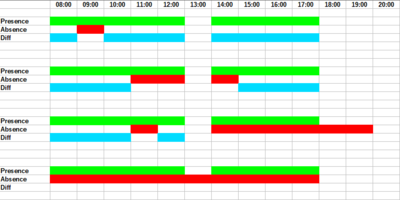A Period Container
The Sequence class is design to ease gathering information about multiple Period instance.
Period detection
Because Period is a value object, comparison between two instances is done using the Period::equals method instead of == or ===.
Sequence::indexOf
Returns the first offset of the a Period object who’s equals to the submitted instance.
$sequence = new Sequence(new Period('2018-01-01', '2018-01-31'));
$sequence->indexOf(new Period('2018-03-01', '2018-03-31')); // 0
$sequence->indexOf(Datepoint::create('2012-06-03')->getDay()); // false
Sequence::contains
public function Sequence::contains(Period $interval, Period ...$intervals);
Tells whether the sequence contains all the submitted intervals.
$sequence = new Sequence(new Period('2018-01-01', '2018-01-31'));
$sequence->contains(
new Period('2018-03-01', '2018-03-31'),
new Period('2018-01-20', '2018-03-10')
); // false
Sequence information
Sequence boundaries
Returns the sequence boundaries as a Period instance. If the sequence is empty null is returned.
$sequence = new Sequence(
new Period('2018-01-01', '2018-01-31'),
new Period('2018-02-10', '2018-02-20'),
new Period('2018-03-01', '2018-03-31'),
new Period('2018-01-20', '2018-03-10')
);
$sequence->boundaries()->format('Y-m-d'); // [2018-01-01, 2018-03-31)
(new Sequence())->boundaries(); // null
Sequence gaps
Returns the gaps inside the instance. The method returns a new Sequence object containing the founded
gaps expressed as Period objects.
$sequence = new Sequence(
new Period('2018-01-01', '2018-01-31'),
new Period('2017-01-01', '2017-01-31'),
new Period('2020-01-01', '2020-01-31')
);
$gaps = $sequence->gaps(); // a new Sequence object
count($gaps); // 2
Sequence intersections
Returns the intersections inside the instance. The method returns a new Sequence object containing the founded
intersections expressed as Period objects.
$sequence = new Sequence(
new Period('2018-01-01', '2018-01-31'),
new Period('2017-01-01', '2017-01-31'),
new Period('2020-01-01', '2020-01-31')
);
$intersections = $sequence->intersections(); // a new Sequence object
$intersections->isEmpty(); // true
Sequence unions
Returns the unions inside the instance. The method returns a new Sequence object containing the calculated unions expressed as Period objects.
$sequence = new Sequence(
new Period('2018-01-01', '2018-01-31'),
new Period('2017-01-01', '2017-01-31'),
new Period('2018-01-15', '2018-02-15')
);
$unions = $sequence->unions(); // a new Sequence object
count($unions); // returns 2
Sequence total timestamp interval
Returns the sum of all instances durations as expressed in seconds.
$sequence = new Sequence(
Period::fromMonth(2017, 1),
Period::fromMonth(2018, 1)
);
$timestamp = $sequence->getTotalTimestampInterval(); // a float
Container manipulations
Sequence::subtract
Sequence::subtract(Sequence $sequence): Sequence
This method enables subtracting a Sequence instance from another one. It internally use Period::subtract and as such is not commutative.
The following diagram gives you an overview of how the method works:
Examples
$presence = new Sequence(
new Period('2000-01-01', '2000-01-10'),
new Period('2000-01-12', '2000-01-20')
);
$absence = new Sequence(
new Period('2000-01-08', '2000-01-10'),
new Period('2000-01-12', '2000-01-15')
);
$diff = $presence->subtract($absence);
$diff[0]->format('Y-m-d'); //[2000-01-01, 2000-01-08)
$diff[1]->format('Y-m-d'); //[2000-01-15, 2000-01-20)
$diff = $absence->subtract($presence);
$diff->isEmpty(); // true

